Archived Storm Damage Blog Posts
5 Ways to Storm-Proof Your Garage Door
1/17/2024 (Permalink)
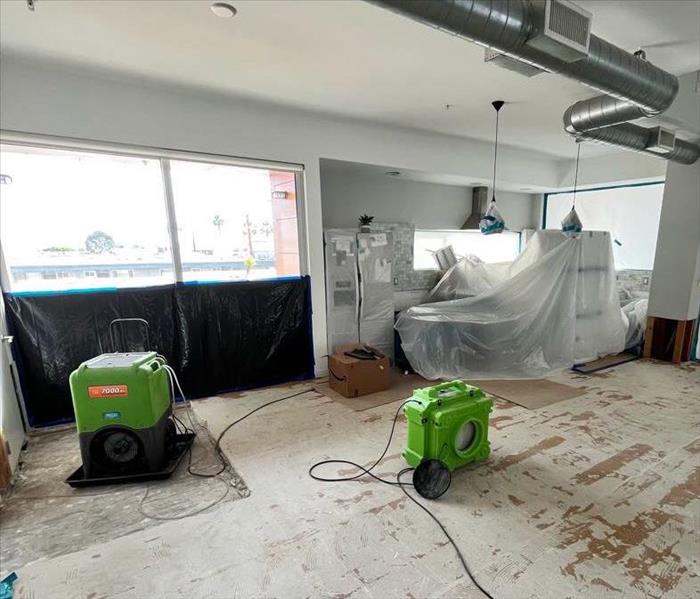 Storm-proofing your garage door is a proactive measure to protect your home and possessions during harsh weather conditions.
Storm-proofing your garage door is a proactive measure to protect your home and possessions during harsh weather conditions.
One often-overlooked area vulnerable to severe weather is the garage door. In this blog, we'll explore five practical ways to storm-proof your garage door, providing you with valuable tips to fortify your home against the elements.
Invest in a Wind-Resistant Garage Door
Upgrade your garage door to a wind-resistant model designed to withstand the force of strong winds during storms. Look for doors with reinforced panels, sturdy bracing, and a solid track system. A professional installation ensures the door is securely fitted, enhancing its ability to endure severe weather conditions.
Install Garage Door Bracing Systems
Consider installing a garage door bracing system to add extra strength and support. These systems typically involve horizontal braces across the door panels and vertical braces connecting the top of the door to the ceiling. Garage door bracing systems provide crucial reinforcement, preventing the door from bowing or collapsing under intense wind pressure.
Seal Gaps and Cracks
A well-sealed garage door is essential for keeping out wind, rain, and debris during storms. Regularly inspect your garage door for any gaps, cracks, or worn-out weatherstripping. Replace damaged weatherstripping and use caulk to seal gaps around the door frame. This not only enhances storm resistance but also improves energy efficiency.
Upgrade to Impact-Resistant Windows
If your garage door features windows, consider upgrading to impact-resistant versions. Impact-resistant windows are designed to withstand flying debris and extreme weather conditions. This adds an extra layer of protection to your garage, minimizing the risk of damage during storms.
Regular Maintenance
Consistent maintenance is key to ensuring your garage door remains storm-resistant. Check for loose hardware, tighten bolts and screws, and lubricate moving parts regularly. Address any issues promptly to keep your garage door in optimal condition and ready to face severe weather.
Storm-proofing your garage door is a proactive measure to protect your home and possessions during harsh weather conditions. Whether through wind-resistant doors, bracing systems, sealing gaps, impact-resistant windows, or regular maintenance, these strategies enhance the resilience of your garage door. Remember, if your property faces storm-related damage, SERVPRO of Loveland is here 24/7 to provide professional restoration services!
Protecting Your Property from Falling Trees during a Windstorm
9/27/2023 (Permalink)
Windstorms are a common occurrence during the fall and winter months. These powerful storms bring strong winds that can cause trees to fall, posing a significant risk to your property. Understanding the potential dangers and taking proactive measures to protect your property from falling trees is crucial. In this blog post, we will explore some steps you can take to safeguard your property during windstorms.
Assess Tree Health
The first step in protecting your property from falling trees is to assess the health of the trees on your property. Look for signs of tree decay, such as hollowed-out trunks or large cavities, dead branches, or excessive leaning. These signs indicate potential weakness and make the tree more susceptible to falling during a windstorm. If you notice any of these warning signs, it is important to consult with a professional arborist to determine if the tree needs to be removed or if it can be pruned to reduce the risk of falling.
Pruning your trees regularly is an essential step in minimizing the risk of falling branches during a windstorm. Proper pruning techniques involve removing dead or weak branches, thinning out dense canopies, and trimming branches away from buildings, power lines, and other structures. It is recommended to hire a certified arborist for this task, as they have the expertise to prune trees safely and effectively.
Remove Hazardous Trees
If you have trees on your property that are extensively decayed, have large cavities, or are leaning dangerously, it may be necessary to remove them entirely. Hazardous trees pose a significant risk during windstorms and can cause significant damage to your property if they fall. Consult with a professional arborist to assess the condition of hazardous trees and determine the best course of action.
For trees that are valuable to your property or heritage trees that may have structural issues, installing tree supports and bracing systems can provide additional stability and reduce the risk of falling during windstorms. A professional arborist can assess the tree's condition and recommend appropriate tree support systems to protect your property.
Secure Outdoor Items
During windstorms, even small objects can become dangerous projectiles. Secure outdoor items such as patio furniture, garden tools, and children's toys to prevent them from being carried by the wind and causing damage to your property or neighboring structures. Store lightweight items in a safe location or tie them down securely.
If you have trees located near your home or other structures, it is crucial to maintain a safe distance between them. The general guideline is to have a buffer zone of at least the height of the tree away from buildings. This allows enough space for the tree to fall without causing significant damage to your property.
Windstorms can be powerful and pose a significant risk to your property from falling trees. By assessing tree health, properly pruning trees, removing hazardous trees, installing tree supports, securing outdoor items, and maintaining a safe distance, you can minimize the potential damage caused by falling trees during windstorms. Taking proactive measures will give you peace of mind and protect your property during windstorms.
Beyond Flooding: Understanding the Different Types of Storm Damage and How to Prepare
6/14/2023 (Permalink)
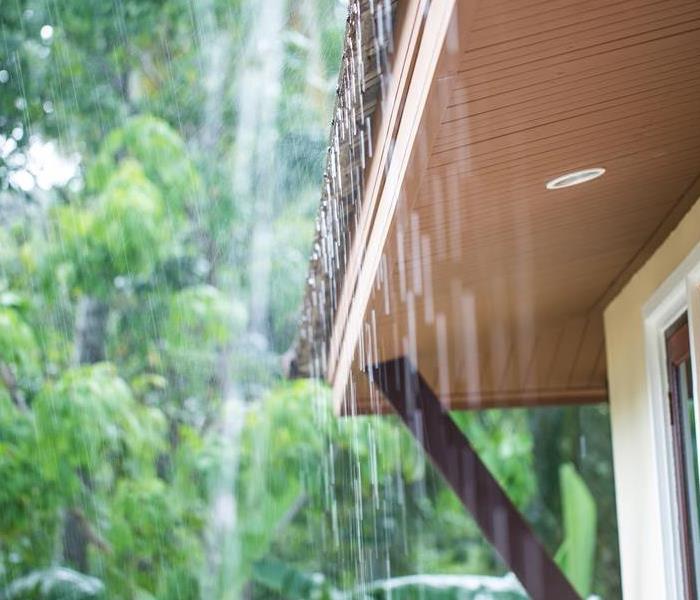 Storm damage can cause a variety of problems including your gutters and roof.
Storm damage can cause a variety of problems including your gutters and roof.
When most people think of storm damage, they often imagine heavy rains and flooding. However, storm damage can take many forms and can be caused by a variety of weather conditions. Preventing storm damage in the first place can save you a lot of time, money, and stress. Some preventative measures include regular property inspections, trimming trees and branches near your property, securing outdoor items, installing storm shutters or impact-resistant windows, and reinforcing your roof. By taking these preventative measures, you can help minimize the risk of storm damage to your property and ensure the safety of your family during severe weather events. Here are some examples of storm damage that don't involve rain flooding.
High winds
Strong winds can cause extensive damage to your property, including roof damage, broken windows, fallen trees, and power outages. It's important to take precautions such as trimming trees, securing outdoor furniture, and boarding up windows to minimize the impact of high winds.
Hail
Hail can cause significant damage to your property, including dented roofing, broken windows, and damaged siding. If you notice any signs of hail damage, it's important to address it promptly to prevent further damage.
Lightning strikes
Lightning strikes can cause fires, power surges, and damage to electronics. It's important to have surge protectors and smoke detectors in place to minimize the impact of lightning strikes.
Tornadoes
Tornadoes can cause extensive damage to your property, including roof damage, broken windows, and collapsed structures. It's important to have a plan in place for tornadoes, including a designated safe room and emergency supplies.
Extreme temperatures
Extreme temperatures, such as heat waves or cold snaps, can cause damage to your property, including burst pipes and damaged roofs. It's important to take precautions such as insulating pipes and properly ventilating your home to prevent damage from extreme temperatures.
If your property has been affected by storm damage, it's important to take action quickly to minimize the impact and prevent further damage. This may include contacting your insurance company, taking photos of the damage, and making temporary repairs to prevent further damage, such as covering broken windows or tarping a damaged roof. It's also important to prioritize your safety and avoid entering your property if there is any risk of structural damage or electrical hazards. By taking swift action and working with professionals such as insurance adjusters and contractors, you can help get your property back to its pre-damaged state and ensure the safety and comfort of your family.
In conclusion, storm damage can take many forms and can be caused by a variety of weather conditions. By being aware of the potential sources of storm damage and taking preventative measures, you can help minimize the impact of storm damage on your property. It's also important to have a plan in place for emergencies and to stay informed about weather conditions in your area.
Can Solar Panels Withstand a Storm?
7/20/2022 (Permalink)
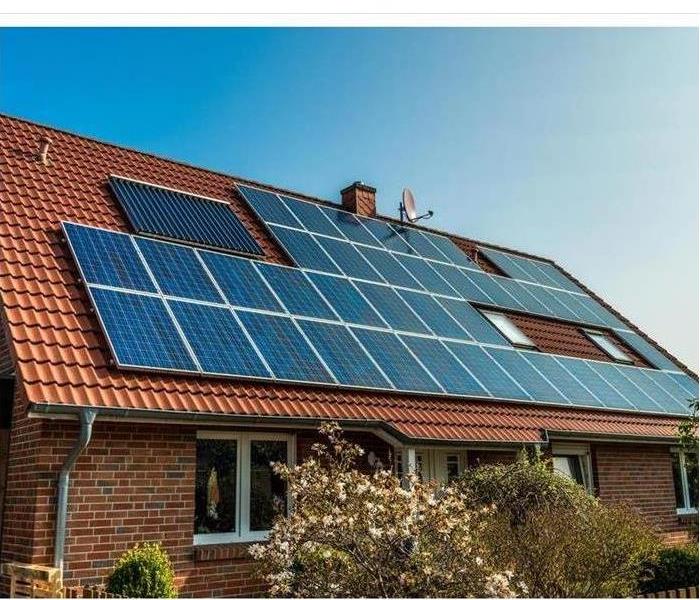 Solar panel in a home in Loveland, CO.
Solar panel in a home in Loveland, CO.
Are Solar Panels Storm-Resilient?
If you are considering installing solar panels on your home, you may be concerned about the potential for panel damage caused by severe storms. Fortunately, most panels hold up well to storm damage.
Hail Damage
Large hail can cause roof damage and may be a concern for many homeowners who have installed solar power equipment. However, the panels are considered generally safe for several reasons:
A study by the National Renewable Energy Laboratory determined that the probability of a solar panel being damaged by hail is below .05%.
Manufacturers test their panels to ensure they can withstand extreme weather conditions.
Panels have been designed to absorb the impact of large hailstones without incurring damage.
Hurricanes
Anything attached to a home in an area that experiences hurricanes need to be able to withstand high winds. Most solar panels have been tested to ensure that they can withstand winds up to 140 miles per hour without suffering panel damage. If you live in an area that experiences hurricanes, check with the manufacturer of your panels to determine whether they have been tested to withstand high winds.
Rain
Rain that enters homes due to damage caused by storms can create a lot of damage and require the services of a water mitigation company in Loveland, CO. However, not only are most panels resistant to leaks, they often work more efficiently after a rainstorm because the rain washes away dirt, dust, and pollen that may accumulate on the panels.
Solar panel manufacturers know their products are designed to be used in environments where they will face frequent exposure to high winds, rain, and other extreme weather conditions. As a result, most solar panels are manufactured and tested to ensure they can withstand these conditions without suffering panel damage. Check with the manufacturer if you have any concerns about the ability of your panels to withstand weather conditions in your area before installing your panels.
3 Keys for Taking Care of Your Sump Pump
6/19/2022 (Permalink)
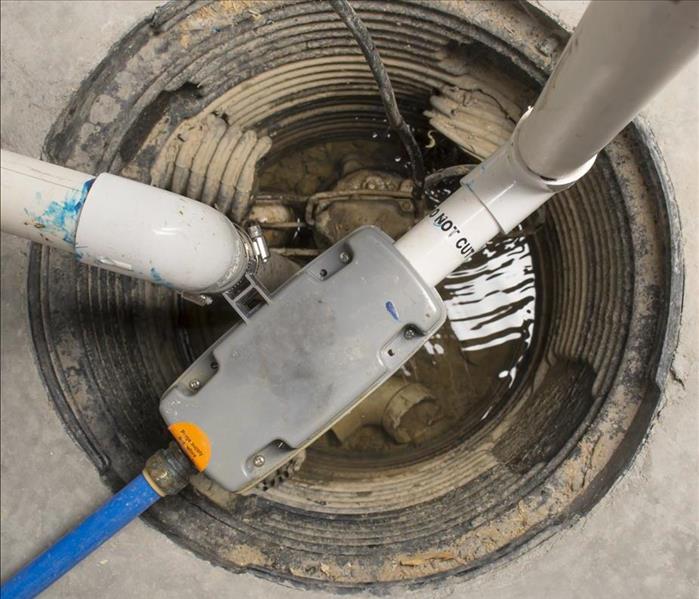 A sump pump is a good insurance against water damage.
A sump pump is a good insurance against water damage.
Three Tips for Maintaining Your Sump Pump
If your home in Loveland, CO, faces a water emergency it is good to have a working sump pump on hand. These devices can clear away hundreds of gallons of water in a short time, preventing water from flowing into vulnerable areas that have carpeting, furniture and other items. Of course, the unit won't be much help if it doesn't work when you need it. To avoid this, take a few simple actions before it is too late.
1. Read the Owner's Manual
Each pump is a little different, so taking a look at the manual is never wasted time. It should cover the essential elements of pump maintenance, such as replacing backup batteries and other components promptly. It will also cover safety concerns, including always using a quality cord and ensuring the unit is plugged into a working ground fault circuit interrupter outlet.
2. Check the Sump Pump Intake and Outtake
Home pumps are not overly complicated. They need the power to operate and suck water in and discharge it to another location. Make sure there is no material impeding this central function. If the pump does fail and water does overflow, you should consider calling a nearby water mitigation company. Trained technicians will arrive shortly and remove any standing water, dry out your home and address any other concerns.
3. Test the Device
By pouring in some water in the proximity of the pump, you can observe if it is working properly. The rising water should lift a float that activates the pump and then you should hear the sound of the unit at work. Water should flow freely through the device. If it doesn't, check to make sure the discharge pipe and vent hole are free of obstructions.
A sump pump is a good insurance against water damage. A few simple steps will make sure it operates as intended.
Are You At Risk for Flood Damage? Here's How To Prepare
5/11/2022 (Permalink)
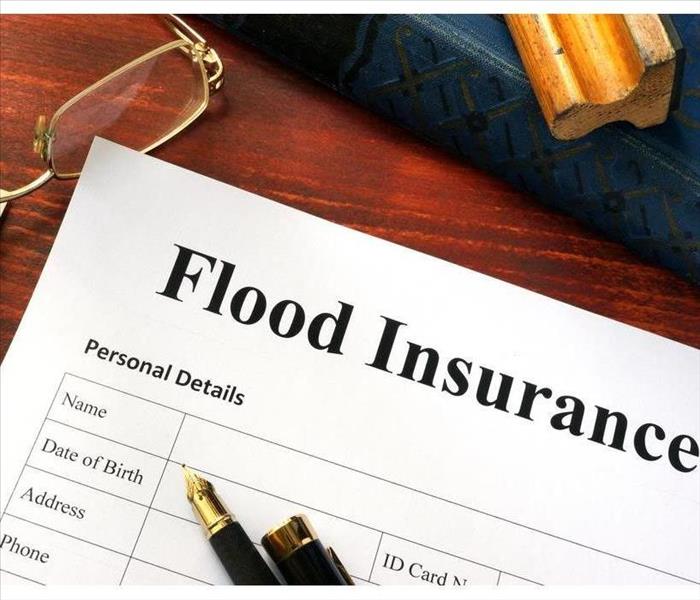 It's a good idea to take out a flood insurance policy.
It's a good idea to take out a flood insurance policy.
Steps To Prevent Flood Damage In Your Home
As a homeowner in Loveland, CO, you have a crucial role to play in preventing flood risk. Many people are not aware that most homeowners' insurance policies do not cover damage from floods. Because of this, you must take preventative steps to prevent flood damage in your home and ensure you have adequate insurance coverage, such as a FEMA NFIP policy.
What Does a Homeowners' Insurance Policy Cover?
A typical home insurance policy covers water damage if it is sudden and accidental. Examples include:
- A pipe bursts, soaking and warping your wood floor.
- Your water heater breaks and sprays the surrounding drywall with water.
- During a thunderstorm, a limb falls on your roof, tearing a hole and letting rain in the house.
However, you need separate insurance for flooding damage. Home insurance does not cover an overflowing sewer drain on your property, a swollen riverbank, and poorly maintained pipes that corrode and leak.
Should You Get FEMA NFIP Flood Insurance?
You can check a flood map on FEMA's website to determine if you live in an area at high risk of flooding. If you do, it's a good idea to take out a flood insurance policy.
The FEMA National Flood Insurance Program is a federally-backed flood insurance program. It is available through private insurers to communities and states that enforce and adopt flood-plain management regulations. Call your agent to learn more or visit the FEMA website.
How Can You Prevent Flood Damage?
Some steps FEMA recommends to protect your home include:
- Raising it above the base flood elevation
- Installing a sump pump
- Sealing your basement walls
- Using flood-resistant drywall and insulation
- Installing flood vents in enclosed places, such as garages and foundation walls
Sometimes, even the best preparation doesn't prevent damage. If you experience a flood, you can call a professional restoration company to help with remediation.
Flooding can do a lot of damage, but fortunately, you have ways to deal with it. Consult your insurance agent about obtaining a FEMA NFIP policy to protect your home.
Storm Damage Is Far More Than Flooding
4/14/2022 (Permalink)
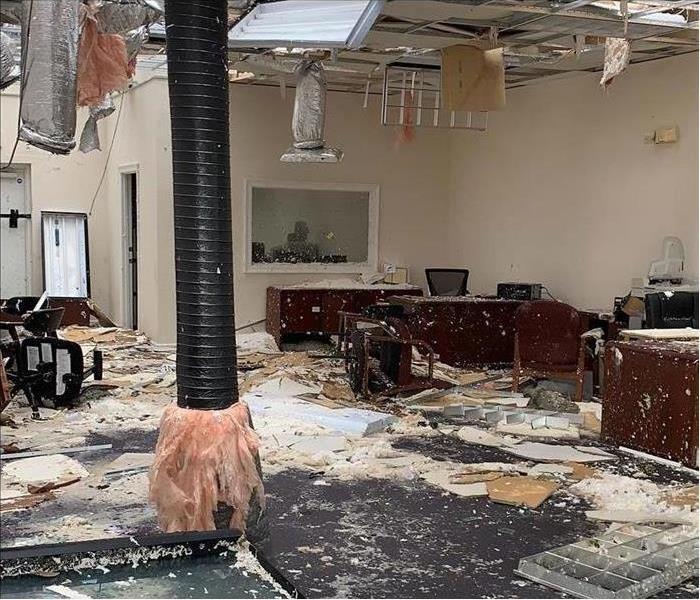 Storm damage in Loveland, CO
Storm damage in Loveland, CO
Flooding Isn't the Only Problem Storms Cause
Major storm systems pose a serious flood damage threat to commercial buildings in Loveland, CO. Rising waters can devastate the foundation, valuables and overall structure, leaving proprietors with a great deal of sogginess. Owners, though, should be aware that storms have other hazardous impacts that demand attention. To minimize concerns, know the answers to the following three questions.
1. What Other Factors Should Owners Prepare For?
Storm damage is a broader category than flood trouble. A hurricane or thunderstorm can have intense wind speeds, capable of harming the roof and turning minor objects into projectiles. Roof shingles may be ruined, exposing the roofing to moisture. This isn't considered flood but water damage. Hail can also occur, creating bumps and holes in the roof.
Furthermore, external items such as furniture, branches or trees can slam into the walls, windows and doors, breaking glass and exposing the room.
2. What Exactly Falls Into Flood Damage?
As the rain pounds down, waters rise, possibly overflowing external bodies of water. Rivers, oceans and the sewer system all dangerous, pouring category three fluid into the premises. Floodwaters such as these can ruin property. The source of the exposure must come from the rise in the water and not the storm itself. Insurance companies examine these case-by-case. Storm complications leading to saturation would not fall under this category.
3. How Should Owners Handle These Events?
When flooding happens (whether it's storm-related or not), commercial owners should turn to professionals at a water and storm restoration company. These certified experts examine the space, test the walls and air and initiate mitigation efforts immediately. This phase is essential to ensure that excess fluid doesn't spawn mold and mildew growth and prepare an appropriate sanitation plan.
What may seem like flood damage might not be. If the water comes from the roof or a structural breach, it's likely to fall into the storm zone. Either way, it's important to act quickly to reduce secondary complications.
 Storm-proofing your garage door is a proactive measure to protect your home and possessions during harsh weather conditions.
Storm-proofing your garage door is a proactive measure to protect your home and possessions during harsh weather conditions.


 24/7 Emergency Service
24/7 Emergency Service




